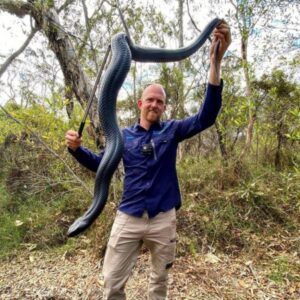Snake catcher Stuart McKenzie finds social media stardom in unexpected career

Stuart McKenzie of Sunshine Coast Snake Catchers in Australia has removed venomous serpents — and the occasional plastic toy — from inside and outside Queensland homes, but despite a lifelong love of reptiles, he said the career path came about unexpectedly.
McKenzie, whose popular social media videos led to he and his team starring in National Geographic Australia series Aussie Snake Wranglers, said his love of reptiles began when he was a child and had lizards as pets “rather than the standard dog or cat.”
McKenzie’s love of animals led to his studying zoology and marine biology at the University of Townsville.
“I didn’t really think I was going to get into snake catching at that time,” McKenzie said.
Unexpected places
McKenzie and his team of about five full-time employees at Sunshine Coast Snake Catchers now travel around the region every day to relocate snakes from inside and outside of people’s homes.

The team posts videos of their rescues to social media, where they frequently go viral. One recent video that proved popular on Facebook involved the team removing a red-bellied black snake that was discovered inside a moving car when it slithered across the occupants’ feet.
“That was pretty crazy, that’s the first time that’s happened in several years,” he said of the hitchhiking serpent.
He said it’s far more common for snakes to turn up inside homes.
“I’ve caught them inside ovens, tucked up inside fridges, I’ve caught them under beds — even under someone’s pillow, or tucked in behind the pillows,” he said. “You could walk around your house and point at any object or any area of your house and I’ve probably caught a snake there.”
McKenzie said it’s also not uncommon for a snake catcher to arrive at a home to find the reported reptile was a plastic toy, bungee strap, garden hose or, in one memorable case, a purse strap.
“She wouldn’t even go inside, she was that freaked out,” McKenzie recalled of the purse’s owner. “She was like, ‘Oh, look through the window,’ and I’m looking through the window and it kind of looked like a snake curled up, and it didn’t at the same time.”
Another memorable false alarm involved a glass-bottom table on a caller’s patio.
“We’d had a bit of rain or a bit of moisture in the morning, and a bead of water, like a water droplet, had gone underneath the table in the shape of a snake. It basically left this water imprint underneath and she thought it looked like a snake,” he said.
Snake safety
McKenzie said he relies on his “experience and skills” more than safety gear when capturing snakes, even venomous species like red-bellied black snakes and eastern brown snakes. He said those two species are among his favorites to catch.
“Red-belly just because I love working with them, they’re quite good to handle, they’re a very shy snake, but they’re just a stunning snake,” he said. “Brown snakes just because they’re a challenge. Trying to catch a brown snake on a warm summer’s day gets the adrenaline going and it’s a challenge, you’ve got to be good at your job to be able to do it.”
“I have been bitten by a yellow-face whip snake, which is a mildly venomous snake, it didn’t really do anything. And also a brown tree snake, which is also mildly venomous. I’ve had some very close calls with browns and red-bellies, but thankfully, no bites,” he said.
The variety of local snake species keeps the job interesting, McKenzie said.
“We’re lucky here on the Sunshine Coast, some other snake catchers in other areas of Australia, they only catch literally a brown snake, a red-belly and maybe a python and that’s it, whereas we’ve got maybe 15 species of snake here that we could potentially catch or run into on a weekly basis.”
Fear of snakes
He said a lot of the public’s fear of snakes comes from common misconceptions.
“One of the biggest ones is people think snakes will chase them,” he said. “And we try and drill that into people that they don’t. Snakes will advance at someone, they’ll defend themselves, but that all comes down to their defensive behavior, they’re not actively chasing someone.”
He said the best thing people can do to protect themselves from snakes is to learn about the animals.





